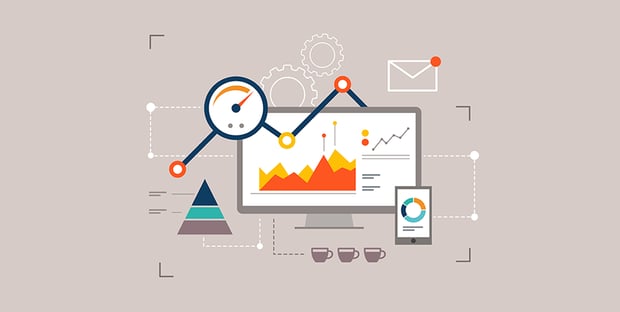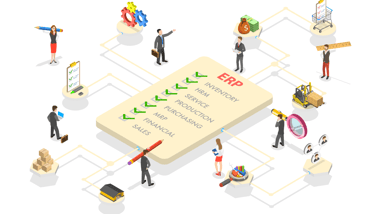it’s impossible to anticipate every question you’ll face from the board, the CEO, and other stakeholders. “I’ll get back to you on that,” was about the best you could do in the past. But ad hoc reporting (and ad hoc reporting software) makes getting back to you a matter of minutes. And gives you an edge you didn’t have before.
Ad hoc reporting, essentially, allows you to retrieve the data you need and prepare a report in minutes to answer even the most unexpected or niche questions. This solves a major problem facing CFOs today: one survey found that 77% of CFOs had to put off major business decisions because they were not able to access data fast enough.
In some cases, where every delay can result in massive costs to your business (or potentially have you miss out on an opportunity entirely) this is unacceptable.
Worse yet, roughly 50% of CFOs claimed that it takes 11 days or more to get reports into the hands of stakeholders in an Association for Financial Professionals survey - a task that the majority of them would like to reduce to fewer than five days.
“50% of CFOs take 11 days or more to get
reports to stakeholders…most would like to take less than five”
Association of Finance Professionals
Speed, accuracy, and easily accessible data are inalienable components of the modern, hyper-efficient CFO. When you can answer the board with a detailed report that you literally built before their eyes, you become that rockstar CFO that demonstrates extraordinary value to the business beyond keeping the books and financials in order.
We now have a snapshot of why ad hoc reporting is important - now it’s time to examine in more depth:
- How ad hoc reporting works (and how it’s evolving)
- Benefits of ad hoc reporting
- Ad hoc reporting in excel vs dedicated ad hoc reporting software
- Examples of ad hoc reports and use cases
What Is Ad Hoc Reporting and How Is It Evolving
Let’s begin with a more formal definition - so what is ad hoc reporting and what is an ad hoc report? (If you already have a firm grasp on ad hoc financial reporting, feel free to skip down to more relevant sections).
Ad hoc reporting refers to the generation of customized, on-the-fly reports or queries in response to specific and often immediate needs. This involves extracting data from databases or information systems seamlessly, without relying on predefined or scheduled reports.
Ad hoc reports are flexible and tailored to answer specific business questions or address particular issues. With the ability to perform rapid data analysis and present it in a report that can include data visualizations, accurate forecasts, and other critical data sets to key decision makers, you’re saving time and enabling your business to be more agile.
Business users can select specific data fields, apply filters, set parameters, and format the report according to their preferences, allowing for a high degree of customization. Ad hoc reporting tools and systems enable users to access real-time or near-real-time data, helping organizations make informed decisions using the best data available.
Ad hoc reporting and analysis combines a suite of business intelligence tools and data management functionality to produce accurate reports in moments. This added agility and flexibility empowers stakeholders to make data-driven decisions versus relying on static reports that reference data points that may be weeks or even months old.
Ad hoc tools, in other words, can be take a lot of the frustration out of FP&A while providing more depth of analysis. This can include drag and drop building of the reports, pulling data in real-time from ERPs and other linked databases, producing accurate forecasting on the fly, and more.
Ad hoc reporting changes the way you execute FP&A tasks, and technology (like ad hoc reporting software) changes your ad hoc reporting to be faster, more comprehensive, more intuitive.
Benefits of Ad Hoc Reporting
While we’ve already gone over some of the benefits, let’s go over a few of the benefits in greater detail so you can better understand why we love ad hoc reporting.
These benefits include:
- Customization
- Agile decision making
- Saves time and money
- Facilitates collaboration
Customization
Leading ad hoc reporting software comes with highly customizable dashboards that offer templates you can readily use and modify according to your specific requirements. These dashboards and templates save you time and enable you to quickly uncover the business insights you’re after. Experienced analysts also gain\ the ability to construct queries using the advanced SQL box offers for even greater flexibility. Speaking of . . .
Agile decision making
Markets, the economy, your industry - none of these are static. So why would you rely on weeks or even months old data when the reality you’re facing today can be dramatically different compared to even a week previous. Consider January 2020 and March of that same year - that was a world of difference and businesses had to quickly adapt to an entirely new economic situation. That requires agility. And that agility is only possible when you can easily create ad hoc reports. Couple this capability with rapid visualization functionality, and you’ll be able to provide digestible, comprehensible, accurate insights to stakeholders in moments.
Finance cost savings
One of the biggest issues in financial analysis and reporting is that so much time is devoted to data gathering and validation - vital tasks, yes, but ones that are better performed by algorithms, not finance experts. Your time is much better spent performing analysis and being able to provide actionable insights to your board, CEO, etc. With FP&A taking 10% longer than it did a decade ago despite all the technological advances, creating ad hoc reports using leading ad hoc reporting solutions can save you hours upon hours of busywork while helping you uncover high-value insights that will drive growth.
Facilitates Collaboration
Ad hoc reporting tools are typically very intuitive, stripping the report building process of a lot of its common associated headaches. The easy-to-pick-up nature of many ad hoc reporting software solutions also allows more people to engage in the process, encouraging people that are normally put off by the FP&A process, spreadsheets, and Excel in general to jump in and provide a perspective that normally would be shut out by technology. Best yet, this encourages more stakeholders to participate in the FP&A process, increasing the opportunities for high-value output and insights.
Reporting in Excel vs Dedicated Ad Hoc Reporting Software
Excel is the foundation of 99.9% of FP&A teams. The industry runs on Excel. But while Excel is a great starting tool, it is not the most efficient approach to FP&A when your business begins to grow, and it certainly is weaker compared to FP&A software when it comes to ad hoc reporting.
Ad hoc reporting in Excel is an arduous and involved process that can both be frustrating and time-consuming (thus invalidating one of the core benefits of ad hoc reporting).
Cloud FP&A software is simply better suited to build your ad hoc reports; this software links with your ERP enabling instant data extraction, allowing you to put together ad hoc reports that are using real-time data and are thus more reflective of the current economic/market/industry conditions.
Want to learn more about how FP&A and your ERP can combine to facilitate and expedite your FP&A processes? See our pages on Sage Intacct integrations and NetSuite FP&A solutions.
Examples of Ad Hoc Reports and Use Cases
Use Case 1: Sudden breakdown
Your business owns a factory with an assembly line. That assembly line breaks down resulting in a massive drain on your business, with every minute of downtime costing you potentially dozens of thousands of dollars (automotive manufacturers, for instance, lose about $22,000 per minute of downtime, and 82% of companies experienced unplanned downtime over a three year span in one study, speaking to its pervasiveness).
With the assembly line inoperable, your business is faced with a variety of choices. Replace the machinery, upgrade it, shutter the factory and cut your losses, put in a temporary bridge fix while newer machinery is installed . . .
These all bear significant financial consequences, and therefore these decisions can’t be taken lightly. But time is of the essence. Ad hoc reporting is the solution.
You can generate a report to answer almost any financial question based on company data in minutes.
Use Case 2: On-the-fly analysis
You meet with the CEO and they ask for data on investing in the Tokyo office - you can respond with accurate forecasting data in that same meeting. With ad hoc reporting tools, you’ll be able to analyze the consequences of any discrete action (including forecasting and projecting the total costs and returns) allowing you to leverage data in all your decision making processes moving forward.
Use Case 3: Reporting supplements
Ad hoc reporting can also be used to supplement your typical reporting. Should management want a specific, in-depth report on how inflation can impact revenue streams in the coming quarter, for instance, ad hoc reporting would allow you to develop that report in moments, ensuring that relevant stakeholders have all the necessary information they need to make sound financial decisions.
Fast, Accurate, Insightful Reporting - You're Ready for Ad Hoc Reporting Software
Limelight Cloud FP&A Software has built-in ad hoc reporting functionality that directly pulls data from your ERP in real time, enabling you to build ad hoc reports using the most current data.
Coupled with high degrees of customization and an industry-best learning curve (from novice to expert in a week), get in touch to learn how you can begin taking advantage of comprehensive ad hoc reporting today.






